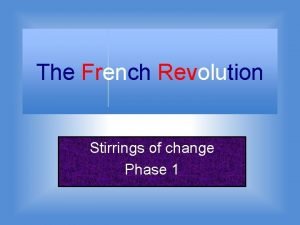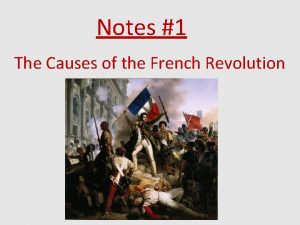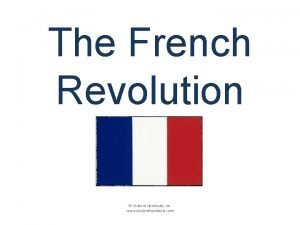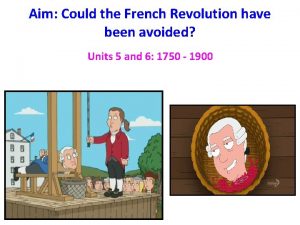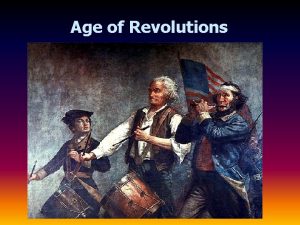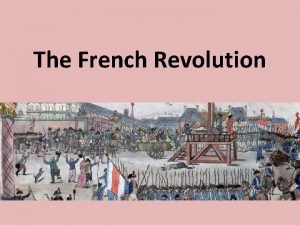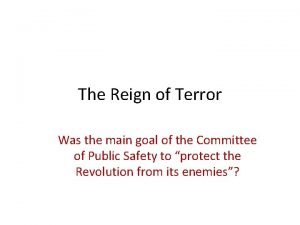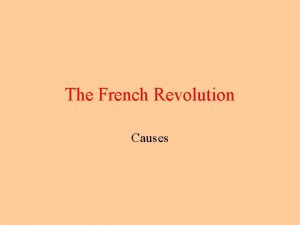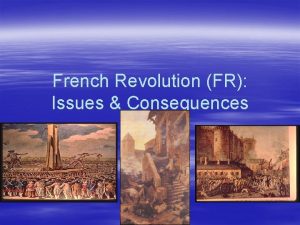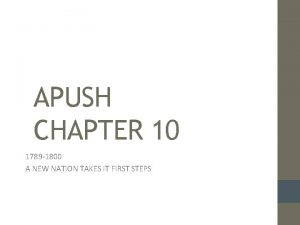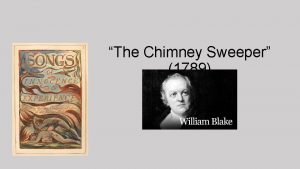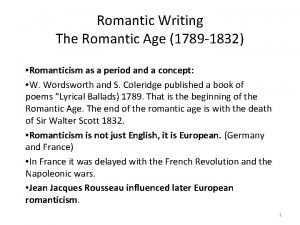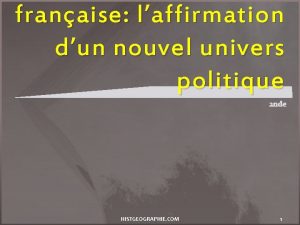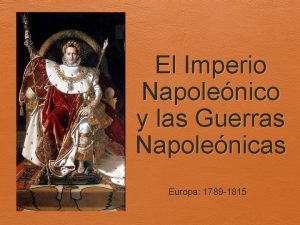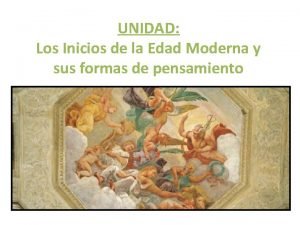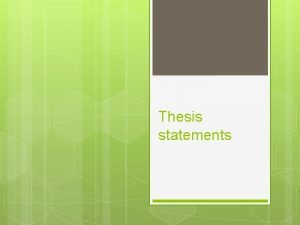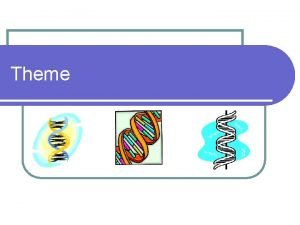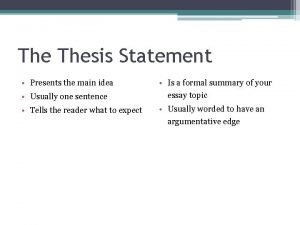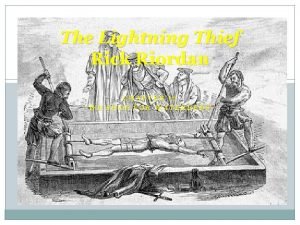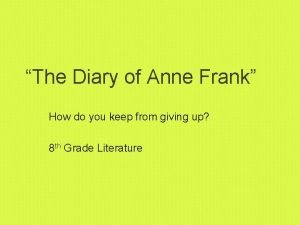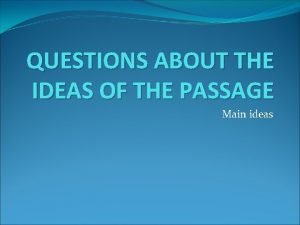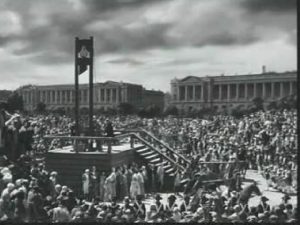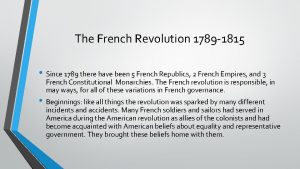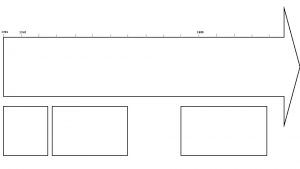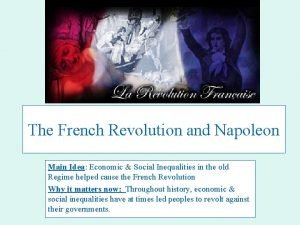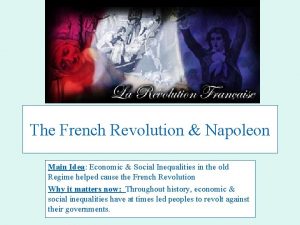French Revolution French Revolution 1789 Main Idea Economic
























![The September Massacres, 1792 M Buveurs de sang [“drinkers of blood. ”] M Over The September Massacres, 1792 M Buveurs de sang [“drinkers of blood. ”] M Over](https://slidetodoc.com/presentation_image_h2/6aac609376bdf0b15a4efddbd3b5373f/image-25.jpg)
































- Slides: 57

French Revolution



French Revolution 1789 Main Idea- Economic & Social in the Old Regime helped cause the French Revolution Why it Matters Now- Throughout history Economic & Social Inequalities have led people to revolt against their governments

Setting the Stage Ø 1700’s –France is the most advanced country in Europe Ø Great unrest caused by high prices, taxes, & questions raised by the Enlightenment ideas of Rousseau & Voltaire

The Old Regime Ø Ø Ø Ø Ø -system of feudalism left over from the Middle Ages Social classes are called Estates Privileged estates 1 st- Roman Catholic Church 2 nd Nobles Third Estate- 98% pop. 1 st Bourgeoisie – merchants & artisans 2 nd- Workers, cooks, servants ect. 3 rd 80% -Peasants- half their money went to taxes


The French Monarchy: 1775 - 1793 Marie Antoinette & Louis XVI

Forces of Change Ø Ø Enlightenment Ideas Equality, Liberty, and Democracy Success of the American Revolution “ Power lies with the People” Economic problems Crop failures(Harsh Winter), Bad leadership (Louis. XVI), & his Wife Marie Antoinette spent money on luxury Ø As a result France was going Bankrupt, he needed money Ø The 2 nd estate made him call a meeting of the Estates General May 5, 1789 the first in 175 years for Tax reform Ø Ø

Convening the Estates General May, 1789 Last time it was called into session was 1614!

The Suggested Voting Pattern: Voting by Estates 1 1 Clergy 1 st Estate Aristocracy 2 nd Estate 1 Commoners 3 rd Estate

The Number of Representatives in the Estates General: Vote by Head! 300 Clergy 1 st Estate Aristocracy 2 nd Estate 300 648 Commoners 3 rd Estate

“The Third Estate Awakens”

Revolution The National Assembly (NA) Ø Under old rules each estate had 1 vote Ø 1&2 would always out vote the poorer 3 rd Ø Abbe Sieyes argued “What is the 3 rd estate ? EVERYTHING” Ø They formed the (N A), Abolishing the king Ø The next day they were locked out Ø They broke down the door & pledged to stay(Tennis court oath) Ø

“The Tennis Court Oath” by Jacques Louis David June 20, 1789

Storming the Bastille Ø The King sensed trouble, ordered the 1&2 to join the N A, at the same time he sent his SWISS Guard to Paris because he did not trust his own army, Ø The people said foreign troops were coming to kill French, they stormed the Bastille to get gun powder, Ø This is National Holiday




The Radical Phase

The National Convention MThe Decree of Fraternity * it offered French assistance to any subject peoples who wished to overthrow their governments. When France sneezes, all of Europe catches cold!

The First Coalition & The Brunswick Manifesto Duke of Brunswick if the Royal Family is harmed, Paris will be leveled!! FRANCE 1792 1797 AUSTRIA PRUSSIA BRITAIN SPAIN PIEDMONT

French Soldiers & the Tricolor: Vive Le Patrie!

The Storming of the Tuilieres: August 9 -10, 1792
![The September Massacres 1792 M Buveurs de sang drinkers of blood M Over The September Massacres, 1792 M Buveurs de sang [“drinkers of blood. ”] M Over](https://slidetodoc.com/presentation_image_h2/6aac609376bdf0b15a4efddbd3b5373f/image-25.jpg)
The September Massacres, 1792 M Buveurs de sang [“drinkers of blood. ”] M Over 1, 000 Parisians killed!

The Jacobins Jacobin Meeting House

A Jacobin Club Meeting

The Sans-Culottes: The Parisian Working Class

The Sans-Culottes Depicted as Savages by a British Cartoonist.

Committee for Public Safety M Revolutionary Tribunals. M 300, 000 arrested. M 16, 000 – 50, 000 executed.

Maximillian Robespierre (1758 – 1794)

Georges Jacques Danton (1759 – 1794)

Jean-Paul Marat (1744 – 1793)

The Assassination of Marat by Charlotte Corday, 1793

The Assassination of Marat by Charlotte Corday (Paul Jacques Aimee Baudry, 19 c)

“The Death of Marat” by Jacques Louis David, 1793

The Levée en Masse: An Entire Nation at Arms! – 500, 000 Soldiers An army based on merit, not birth!

The Reign of Terror is nothing other than justice, prompt, severe, inflexible. -- Robespierre Let terror be the order of the day!

The “Monster” Guillotine The last guillotine execution in France was in 1939.

Louis XVI’s Head (January 21, 1793)

Marie Antoinette on the Way to the Guillotine

Marie Antoinette Died in October, 1793

War of Resistance to the Revolution, 1793

Vendée Revolt, 1793 Drowning the Traitors!

The Contrast: “British Liberty / French Liberty”

The Contrast: “French Liberty / British Slavery”

Religious Terror: De-Christianization (1793 -1794) M The Catholic Church was linked with real or potential counter-revolution. M Religion was associated with the Ancien Régime and superstitious practices. M Very popular among the sans-culottes. M Therefore, religion had no place in a rational, secular republic!

The De-Christianization Program 1. The adoption of a new Republican Calendar: * abolished Sundays & religious holidays. * months named after seasonal features. * 7 -day weeks replaced by 10 -day decades. * the yearly calendar was dated from the creation of the Republic [Sept. 22, 1792] The Convention symbolically divorced the state from the Church!!

The De-Christianization Program 2. The public exercise of religion was banned. 3. The Paris Commune supported the: * destruction of religious & royal statues. * ban on clerical dress. * encouragement of the clergy to give up their vocations. 4. The Cathedral of Notre Dame in Paris was turned into the “Temple of Reason. ” 5. The deportation of priests denounced by six citizens.

The “Temple of Reason” Come, holy Liberty, inhabit this temple, Become the goddess of the French people.

The Festival of Supreme Being A new secular holiday.

Backlash to the De-Christianization Program M It alienated most of the population (especially in the rural areas). M Robespierre never supported it. * he persuaded the Convention to reaffirm the principle of religious toleration. M Decree on the “Liberty of Cults” was passed * December 6, 1793. * BUT, it had little practical effect!

The Terror Intensified: March to July, 1794 Jacques Hébert & the Hérbetists Executed in March, 1794. Danton & the “Indulgents” Executed in April, 1794. Ô Law of 22 Prairial [June 10, 1794]. * Trials were now limited to deciding only on liberty OR death, with defendants having no rights. * Were you an “enemy of the people? ” (the law was so broadly written that almost anyone could fall within its definition!) Ô 1, 500 executed between June & July.

The “Thermidorean Reaction, ” 1794 P July 26 Robespierre gives a speech illustrating new plots & conspiracies. * he alienated members of the CPS & CGS. * many felt threatened by his implications. P July 27 the Convention arrests Robespierre. P July 28 Robespierre is tried & guillotined!

The Arrest of Robespierre

The Revolution Consumes Its Own Children! Danton Awaits Execution, 1793 Robespierre Lies Wounded Before the Revolutionary Tribunal that will order him to be guillotined, 1794.

Bibliographic Resources « “Hist 210—Europe in the Age of Revolutions. ” http: //www. ucl. ac. uk/history/courses/europe 1/ chron/rch 5. htm « “Liberty, Fraternity, Equality: Exploring the French Revolution. ” http: //chnm. gmu. edu/revolution/ « Matthews, Andrew. Revolution and Reaction: Europe, 1789 -1849. Cambridge University Press, 2001. « “The Napoleonic Guide. ” http: //www. napoleonguide. com/index. htm
 Main ideas examples
Main ideas examples October 6 1789 french revolution
October 6 1789 french revolution What was an immediate cause of the 1789 french revolution
What was an immediate cause of the 1789 french revolution May 1789 french revolution
May 1789 french revolution Write the causes of french revolution
Write the causes of french revolution It reveals the main or central idea of a paragraph
It reveals the main or central idea of a paragraph Supporting idea
Supporting idea What is the difference between topic and theme
What is the difference between topic and theme Irrelevant details in a paragraph
Irrelevant details in a paragraph French revolution cartoons
French revolution cartoons Short term causes of the french revolution
Short term causes of the french revolution Storming of the bastille cartoon
Storming of the bastille cartoon You should hope that this game will be over soon
You should hope that this game will be over soon Did american revolution cause french revolution
Did american revolution cause french revolution Main idea in french
Main idea in french France monarchy timeline
France monarchy timeline What was the goal of the reign of terror
What was the goal of the reign of terror Describe the causes of french revolution
Describe the causes of french revolution Russian revolution vs french revolution
Russian revolution vs french revolution Europe in 1789
Europe in 1789 1789 apush
1789 apush French revolution symbol
French revolution symbol The chimney sweeper songs of innocence
The chimney sweeper songs of innocence Bolton romanticism amp; politics 1789 1832 download
Bolton romanticism amp; politics 1789 1832 download Frise républiques françaises
Frise républiques françaises Napoleon 1789
Napoleon 1789 J martin rochester
J martin rochester Europa en 1789
Europa en 1789 Línea de tiempo de la historia
Línea de tiempo de la historia The divisions in spanish colonial society 1789
The divisions in spanish colonial society 1789 1797 - 1789
1797 - 1789 July 14 1789
July 14 1789 1789 france
1789 france Against the gods 1789
Against the gods 1789 Art 1789
Art 1789 1789
1789 Economic growth vs economic development
Economic growth vs economic development Economic development vs economic growth
Economic development vs economic growth Chapter 1 lesson 2 our economic choices worksheet answers
Chapter 1 lesson 2 our economic choices worksheet answers Exegetical idea vs homiletical idea
Exegetical idea vs homiletical idea Penanda wacana untuk penutup
Penanda wacana untuk penutup Concluding paragraph
Concluding paragraph Soccer players learn many skills when playing soccer
Soccer players learn many skills when playing soccer Main idea key words
Main idea key words Title and thesis statement
Title and thesis statement Theme vs topic
Theme vs topic Whats a central idea
Whats a central idea The giver movie theme
The giver movie theme Is thesis statement and main idea the same
Is thesis statement and main idea the same Chapter 17 percy jackson and the lightning thief
Chapter 17 percy jackson and the lightning thief Mr dussel
Mr dussel What do finding nemo and robocop have in common
What do finding nemo and robocop have in common What is the topic of the passage?
What is the topic of the passage? Penguin chick main idea and details
Penguin chick main idea and details Main idea of manifest destiny
Main idea of manifest destiny Major and minor details
Major and minor details Stated and implied examples
Stated and implied examples Complete the main idea by completing the paragraph
Complete the main idea by completing the paragraph

